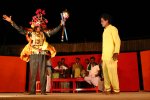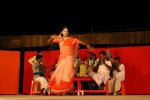The Tamil Nadu Kattaikkuttu Kalai Valarchi Munnetra Sangam is a grassroots organization that promotes the cultural and economic rights of professional Kattaikkuttu performers. It was established in 1990 by a group of seventeen performers belonging to different Kattaikkuttu theatre companies. At present the Sangam has more than two hundred members who live in the northern districts of Tamil Nadu and the Chittoor district of Andhra Pradesh. The Kattaikkuttu Sangam runs the Kattaikkuttu Youth Theatre School, which provides professional Kattaikkuttu training to underprivileged, rural children in combination with basic education. The Sangam provides a framework within which performers can discuss their professional demands and aspirations. It produces new plays, organizes theatre and other creative workshops, in addition to an annual Kattaikkuttu Festival.
The Kattaikkuttu Sangam is the organizer of the Kuttu Festival 2005 through which it wants to celebrate, together with other performers and its regular audiences, the fact that the organization exists fifteen years. For this special occasion a group of thirty-five performers who act in the nine different Kattaikkuttu performances put up by the Sangam, in addition to co-organizing the event. They special performance group represents actors and musicians drawn from two important Kattaikkuttu styles, that from around Kanchipuram-Cheyyar and that found in the Gingee-Vilupuram area.
Kattaikkuttu knows a number of different styles or 'banis'. The Gingee (Cenci) style is prevalent in the area around the provincial town of Gingee in the Viluppuram District of Tamilnadu. A small temple is situated at the outskirts of Gingee. According to local legend this is the original temple of Draupadi, the heroine of the Mahabharata who is worshipped as a Goddess in the northern parts of Tamilnadu. Festivals in honour of Draupadi are characterized by ten or more nights of Kattaikkuttu during which the entire Mahabharata, from Draupadi's marriage until the end of the eighteenth day of the war, is acted out in the centre of the village by local theatre companies. The Gingee style of Kattaikkuttu is characterized by a great emphasis on the female characters who, as compared to the male characters, use vigorous dance movements. Demonic male characters, referred to as suravesham, can be recognized by their huge crowns adorned with black feathers.
2 hours Traditionally a royal sacrifice (rajasuya) is carried out to confer universal sovereignty on a king. However, in the Kattaikkuttu tradition this traditional motif is muted. Instead, the sage Narada—a notorious troublemaker—informs Dharma that he should carry out a royal sacrifice so that his father, the deceased Pandu, can be elevated to heaven. Dharma and Draupadi invoke Lord Krishna and tell him about Narada's advice asking him what they should do. Krishna says that they will need to vanquish a great number of kings and capture their wealth before they can carry out the expensive royal sacrifice. In addition, Dharma will have to get rid of Jarasandha (Caracantan) who has defeated Krishna many times in battle and who apparently is a threat to Dharma's sovereignty. Bhima, Aruba and Krishna disguised as Brahmins set out to slay Jarasandha. They destroy the sacrifice that Jarasandha is about to bring to his family Goddess. Bhima kills Jarasandha by tearing apart the two pieces that were joined together originally in order to give him life. He releases the kings who have been imprisoned by Jarasandha making them subordinates of the Pandavas and ordering them to attend with the royal sacrifice with all their wealth. The kings of all the fifty-five countries of the world are invited for the ceremony.
After Jarasandha's death Bhima, Arjuna and Krishna return to Indraprastha where the rajasuya soon begins. Bhishma, one of the Kaurava elders, proposes that the first honour (tambulam, i.e. betel leaf and areca nut) should be offered to Krishna, acknowledging that he is the most important guest present. Dharma follows this advice, whereupon Sisubala (Cicupalan), King of Cedi, rises in fury. He demands to know how Dharma can bestow this honour on someone as low as Krishna, a mere shepard by caste. Thereupon Krishna takes up his disc (cakra) and severs Sisupala's head. While doing so he hurts himself and bleeds from his finger. Of all the women present at the royal sacrifice, only Draupadi observes this. She tears of the outer-end of her sari and offers it as a bandage to stanch the blood. Krishna promises her that he will help her in return, whenever she needs it, by giving her a sari for every thread contained by the piece of cloth that she has offered him.
After the royal sacrifice Duryodhana is taken for a grand tour of the magnificent palace of the Pandavas, which has many in-built illusionist devices. Duryodhana is unable to see through these, falls, and makes a fool of himself. Draupadi sees him falling and mocks him. She claps her hands to get the attention of her girl-friends and tells them: 'His father is blind but apparently the son cannot see either.' It is this provocative insult that Duryodhana recalls in particular when he arrives back home and which makes him look for a fitting revenge
Tamil Nadu Kattaikkuttu Kalai Valarchi Munnetra Sangam & Kattaikkuttu Youth Theatre School |

